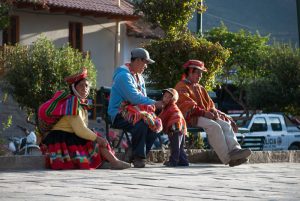In Search of a Suffix and Path, More on Huachafo

Huachafo is a weird word, as I found out while studying its usage.
It is an adjective, though one site insists it is a noun. As a result it occupies a very strange place as one of a very small set of words in Spanish ending with “-fo” that are adjectives.
In fact, the only other member of that set that I have found is fofo, a much older and very Spanish word which basically means spongy or not good. That word is also far more used and in far more countries.
Despite these two words, there appears to be no standard suffix -fo in Spanish that makes adjectives. Both huachafo and fofo are anomalies.
Nevertheless, there is a suffix -fo. This suffix makes nouns Undoubtedly this suffix helps explain why the other site was confused.

However, it is not Spanish per se, rather it is used on foreign words, specifically Greek ones, where it occupies the spot of -pher in English. Thus, the word philosopher is translated as filósofo.

This situation struck me as very curious. As I wrote in an earlier post, I am not convinced by Martha Hildebrandt’s explanation for the origins of huachafo. In addition to what I argued before we can say her special case explanation does not work without some kind of method to get the word into common speech; She provides none such.
rtsy./
Another just so story without a context comes from the Blog de Redacción of the eminent Pontífica Universidad Católica del Perú, the Pontifical Catholic University of Peru. It cites a book by Felipe Lucia Pezer to claim Huachafo comes from an English word Whitechaps, which it writes was how English railway men and others spoke about parvenus whether at home or in Peru. Like others elsewhere, the ones in Peru may get money but lack taste.
This story might seem plausible because of other key loanwords and loan-objects in Peru from the Englishmen, such as gasfitero for the Spanish plomero, or plumber, i.e.gas-fitter. You also find huachiman, to describe the sereno or security agent, watchman. Among objects from the English are beer and Inca Kola, as well as meal items such as sanguches, sandwiches.
However, the ostensible etymology still feels like special pleading and a cute story without a social mechanism to explain the spread of the word once born.
Neither explanation, furthermore, deals with the widespread Quechua loanword in Spanish, huacha. It is so close to huachafo in sound and meaning that it must first be demonstrated to have no possibility of contributing to the word before these other stories can be taken as more than curiosities, no matter the social position of those who propagate them.
The Diario La Primera wrote that Jorge Miota was the first to use the word in print, actually it said he coined the word. It says he did so in an essay in the Actualidades magazine in 1908.
Whether true or not, this made me wonder if we can see a moment of sudden appearance for the word in Spanish letters. Fortunately, Google has invented a tool to help us, their NGRAM, which explores frequency of usage in their mega-collection of books. If a word has forty or more usages in a given year it appears on their charts.
First, we must note that the guachafo spelling does not appear in Google’s very wide collection of works until 1948 and then grows sharply in usage in 1956, which seems to create a problem for Hildebrandt.
Oddly, the guachafita that Hildebrandt cites as the origin of huachafo appears in 1880 with its peak of usage around 1960. It peaks with guachafo. In otherwords, Hildebrandt’s argument suffers from depending on something anachronic.

In its root meaning of something disordered, out of place, Guachafita does seem to relate to huachafo. I can see why Hildebrandt would see this word as somehow engaged with the Peruvianism.
But there is probably a better explanation. The Venezuelan and Columbian word, if you take away the diminutive -ita, is the same as the Peruvian word with the gu- spelling, namely guachafa. It is just feminine.
The more likely explanation is that both the Bolivarian countries (Venezuela and Colombia) as well as Peru had the Quechua loan word guacha, huacha, or wacha. The first two of these appear at the end of the nineteenth century in a variety of works and over a large area of South America. Initially they referred to place names but the meaning of poor or orphan quickly appears. Indeed, of these guacha is the most popular spelling especially at the time huachafo appears.
This word with this spelling appears about the time cited for it, the very early twentieth century. Indeed it is used in one of the most important tales for Peruvian school children, El Trompo, the Top, by Jose Diez Canseco, shortly after this. It peaks in the forties, and then rises to an even higher peak in usage within books in 1983.
This is about the same time the word wacha, in its many spellings also is strongly used.
So, wacha in whichever spelling is most likely the origin of huachafo without some strong reason surfacing to discount it. We still need to account for the suffix and this requires we turn to fofo.
The word fofo, always strongly used in Spanish, reaches a peak shortly before the word huachafo appears, and then again in the forties. It is possible this word is the source of the suffix -fo, attached to the Quechanism huacha to make huachafo. The -fo would then have not only made it an adjective like the original word, it would have carried the negative meaning it had to attach to the Quechua-origin word.
This seems likely to me, though it is also a just so story. The difference between this and the others is that we can show the spread of the word in time after the first moment it appears in writing in Spanish, after the peak of fofo. It grows strongly along with the Quechua word, and the diminutive guachafita, through the twentieth century, a time of urbanization and the growth of an urban class of Indians or former Indians, often called cholos.
Indeed, NGRAM demonstrates the word cholo to have grown very strongly at the same time to a peak in the forties. In other words, this set of terms, wacha, huachafo, guachafita, and cholo grow simultaneously as established urban residents have to confront a changing social reality in the cities. The words’ intent may well have been to describe negatively this new class which would increasingly be the future of Peru.




